University Finance Report: IFRS Analysis for Able Plc, 2017, APC311
VerifiedAdded on 2020/06/06
|14
|4227
|241
Report
AI Summary
This report provides a comprehensive analysis of International Financial Reporting Standards (IFRS) and its application. It begins with an introduction to IFRS and its importance in global business, followed by the preparation of an income statement for Able Plc for the year 2017, adhering to IFRS standards. The report then delves into the evaluation of accounting for intangible assets, focusing on International Accounting Standards (IAS) 38, with specific attention to capitalizing development and research costs. Furthermore, it addresses key issues in international financial reporting and the conceptual framework for accounting, including the valuation of inventories as per IAS 2. The report concludes with a summary of the findings and recommendations for financial reporting practices.
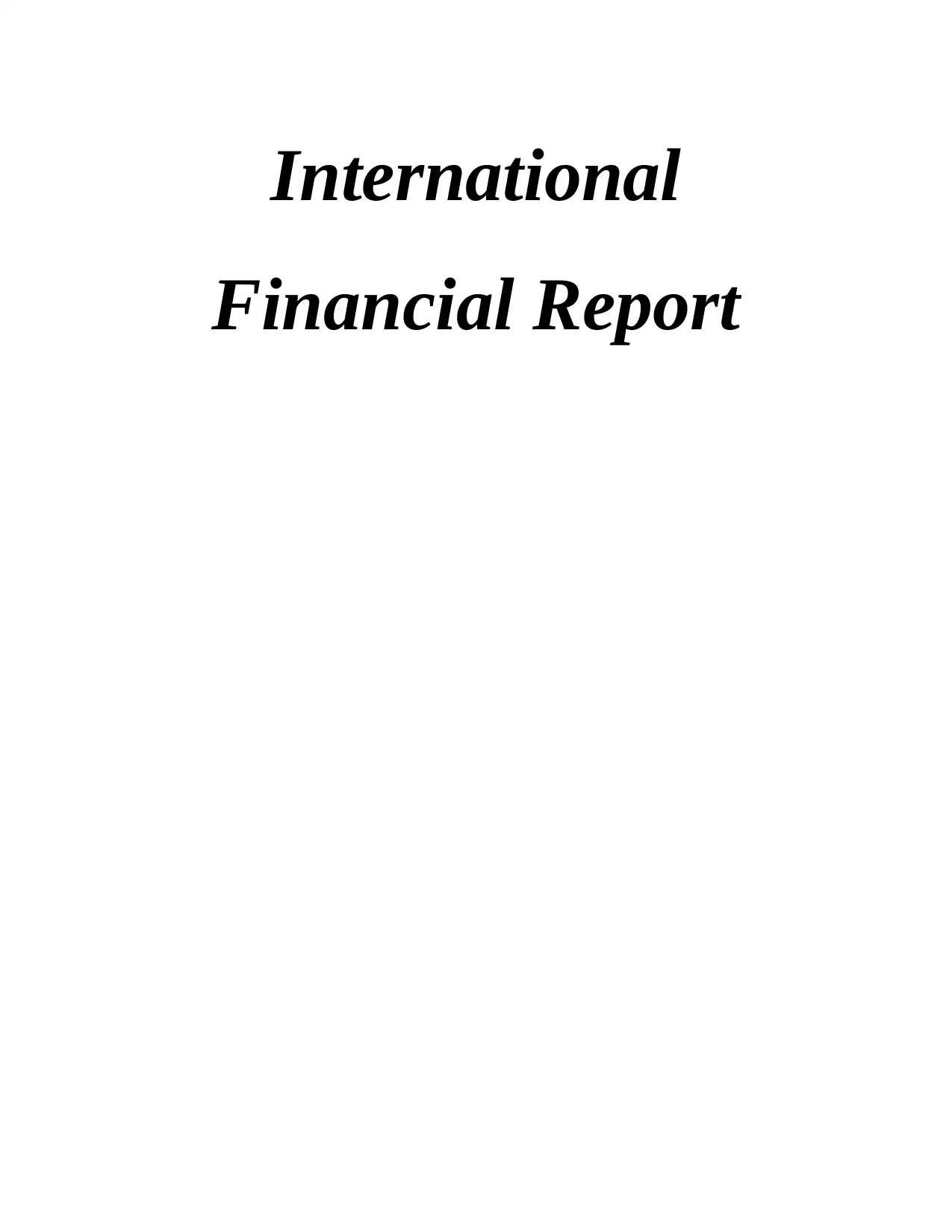
International
Financial Report
Financial Report
Paraphrase This Document
Need a fresh take? Get an instant paraphrase of this document with our AI Paraphraser
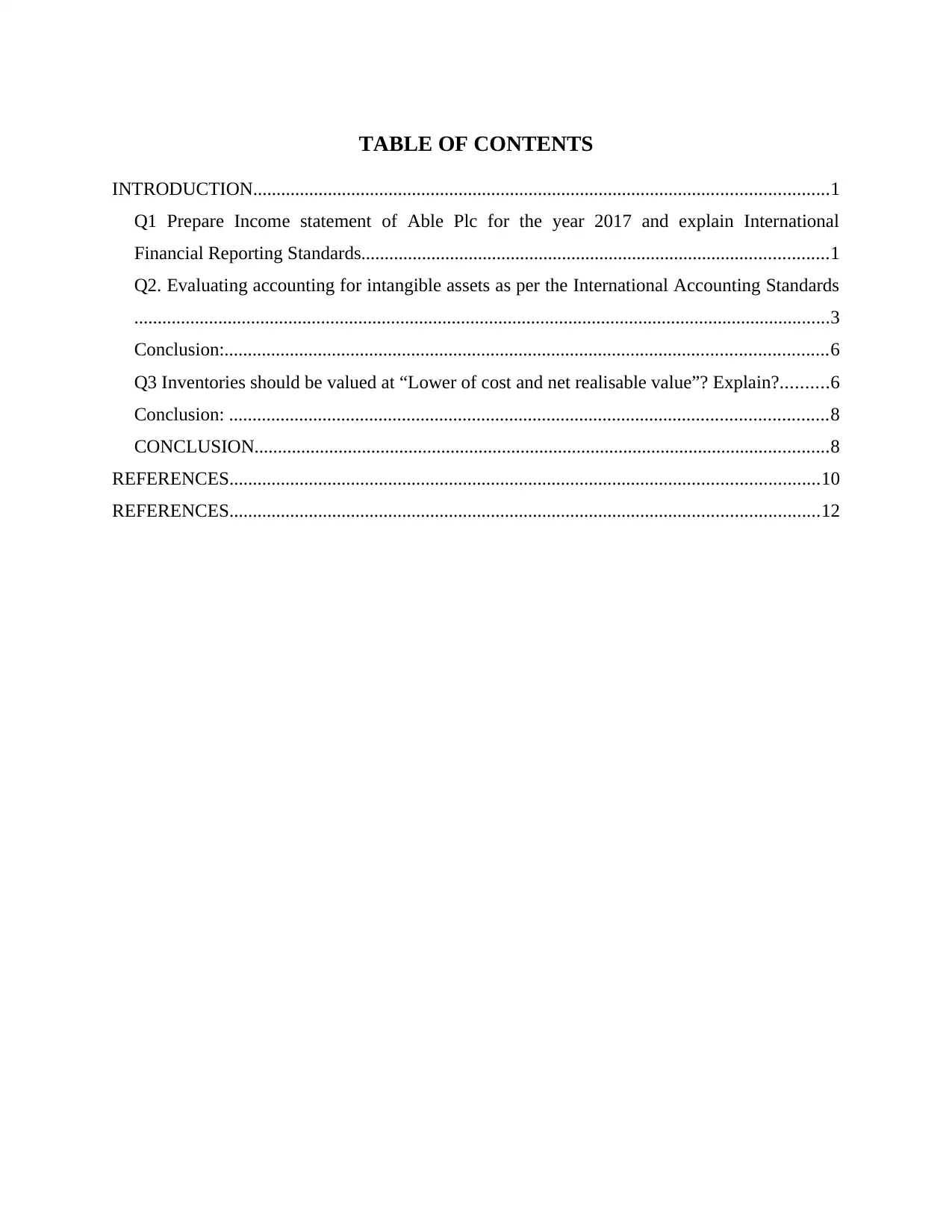
TABLE OF CONTENTS
INTRODUCTION...........................................................................................................................1
Q1 Prepare Income statement of Able Plc for the year 2017 and explain International
Financial Reporting Standards....................................................................................................1
Q2. Evaluating accounting for intangible assets as per the International Accounting Standards
.....................................................................................................................................................3
Conclusion:.................................................................................................................................6
Q3 Inventories should be valued at “Lower of cost and net realisable value”? Explain?..........6
Conclusion: ................................................................................................................................8
CONCLUSION...........................................................................................................................8
REFERENCES..............................................................................................................................10
REFERENCES..............................................................................................................................12
INTRODUCTION...........................................................................................................................1
Q1 Prepare Income statement of Able Plc for the year 2017 and explain International
Financial Reporting Standards....................................................................................................1
Q2. Evaluating accounting for intangible assets as per the International Accounting Standards
.....................................................................................................................................................3
Conclusion:.................................................................................................................................6
Q3 Inventories should be valued at “Lower of cost and net realisable value”? Explain?..........6
Conclusion: ................................................................................................................................8
CONCLUSION...........................................................................................................................8
REFERENCES..............................................................................................................................10
REFERENCES..............................................................................................................................12
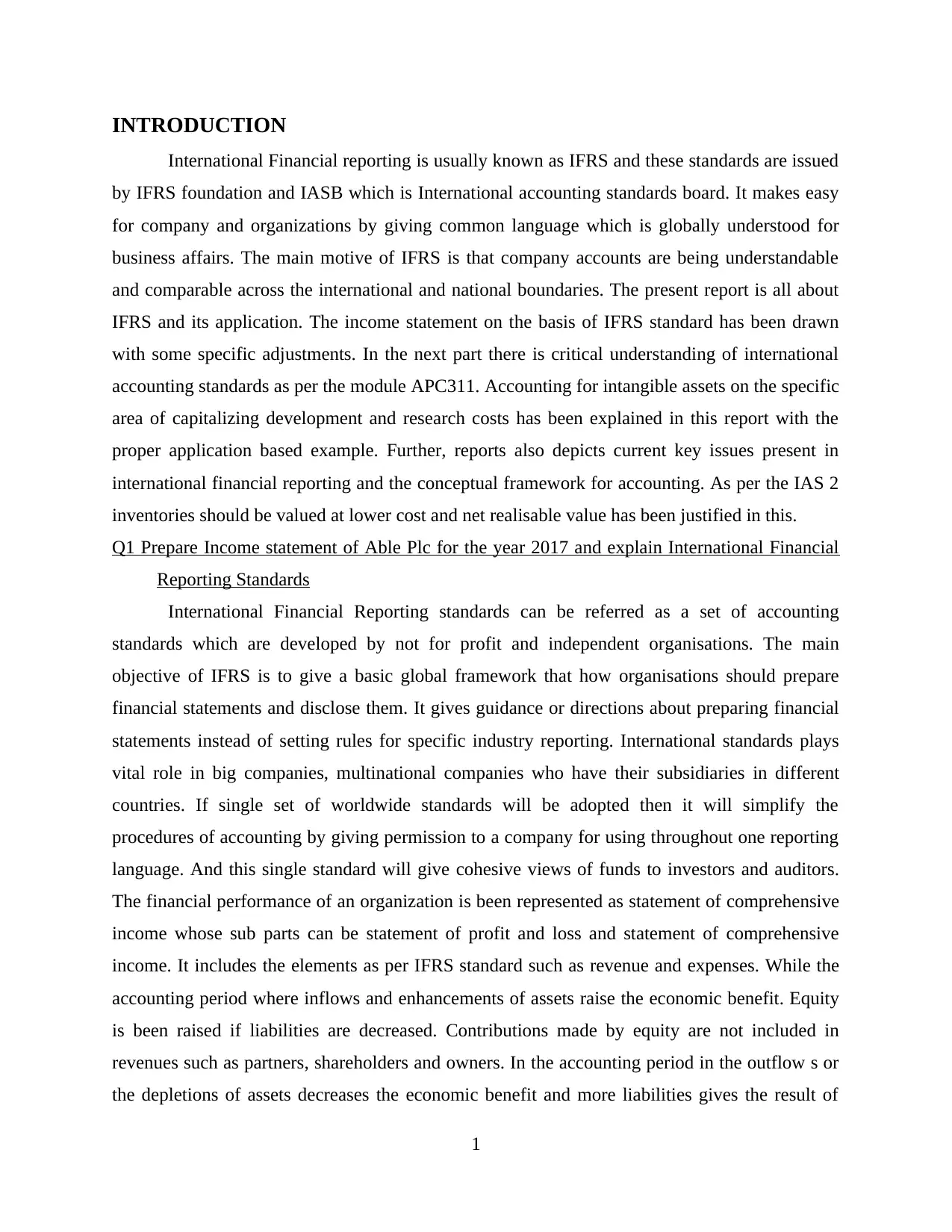
INTRODUCTION
International Financial reporting is usually known as IFRS and these standards are issued
by IFRS foundation and IASB which is International accounting standards board. It makes easy
for company and organizations by giving common language which is globally understood for
business affairs. The main motive of IFRS is that company accounts are being understandable
and comparable across the international and national boundaries. The present report is all about
IFRS and its application. The income statement on the basis of IFRS standard has been drawn
with some specific adjustments. In the next part there is critical understanding of international
accounting standards as per the module APC311. Accounting for intangible assets on the specific
area of capitalizing development and research costs has been explained in this report with the
proper application based example. Further, reports also depicts current key issues present in
international financial reporting and the conceptual framework for accounting. As per the IAS 2
inventories should be valued at lower cost and net realisable value has been justified in this.
Q1 Prepare Income statement of Able Plc for the year 2017 and explain International Financial
Reporting Standards
International Financial Reporting standards can be referred as a set of accounting
standards which are developed by not for profit and independent organisations. The main
objective of IFRS is to give a basic global framework that how organisations should prepare
financial statements and disclose them. It gives guidance or directions about preparing financial
statements instead of setting rules for specific industry reporting. International standards plays
vital role in big companies, multinational companies who have their subsidiaries in different
countries. If single set of worldwide standards will be adopted then it will simplify the
procedures of accounting by giving permission to a company for using throughout one reporting
language. And this single standard will give cohesive views of funds to investors and auditors.
The financial performance of an organization is been represented as statement of comprehensive
income whose sub parts can be statement of profit and loss and statement of comprehensive
income. It includes the elements as per IFRS standard such as revenue and expenses. While the
accounting period where inflows and enhancements of assets raise the economic benefit. Equity
is been raised if liabilities are decreased. Contributions made by equity are not included in
revenues such as partners, shareholders and owners. In the accounting period in the outflow s or
the depletions of assets decreases the economic benefit and more liabilities gives the result of
1
International Financial reporting is usually known as IFRS and these standards are issued
by IFRS foundation and IASB which is International accounting standards board. It makes easy
for company and organizations by giving common language which is globally understood for
business affairs. The main motive of IFRS is that company accounts are being understandable
and comparable across the international and national boundaries. The present report is all about
IFRS and its application. The income statement on the basis of IFRS standard has been drawn
with some specific adjustments. In the next part there is critical understanding of international
accounting standards as per the module APC311. Accounting for intangible assets on the specific
area of capitalizing development and research costs has been explained in this report with the
proper application based example. Further, reports also depicts current key issues present in
international financial reporting and the conceptual framework for accounting. As per the IAS 2
inventories should be valued at lower cost and net realisable value has been justified in this.
Q1 Prepare Income statement of Able Plc for the year 2017 and explain International Financial
Reporting Standards
International Financial Reporting standards can be referred as a set of accounting
standards which are developed by not for profit and independent organisations. The main
objective of IFRS is to give a basic global framework that how organisations should prepare
financial statements and disclose them. It gives guidance or directions about preparing financial
statements instead of setting rules for specific industry reporting. International standards plays
vital role in big companies, multinational companies who have their subsidiaries in different
countries. If single set of worldwide standards will be adopted then it will simplify the
procedures of accounting by giving permission to a company for using throughout one reporting
language. And this single standard will give cohesive views of funds to investors and auditors.
The financial performance of an organization is been represented as statement of comprehensive
income whose sub parts can be statement of profit and loss and statement of comprehensive
income. It includes the elements as per IFRS standard such as revenue and expenses. While the
accounting period where inflows and enhancements of assets raise the economic benefit. Equity
is been raised if liabilities are decreased. Contributions made by equity are not included in
revenues such as partners, shareholders and owners. In the accounting period in the outflow s or
the depletions of assets decreases the economic benefit and more liabilities gives the result of
1
⊘ This is a preview!⊘
Do you want full access?
Subscribe today to unlock all pages.

Trusted by 1+ million students worldwide
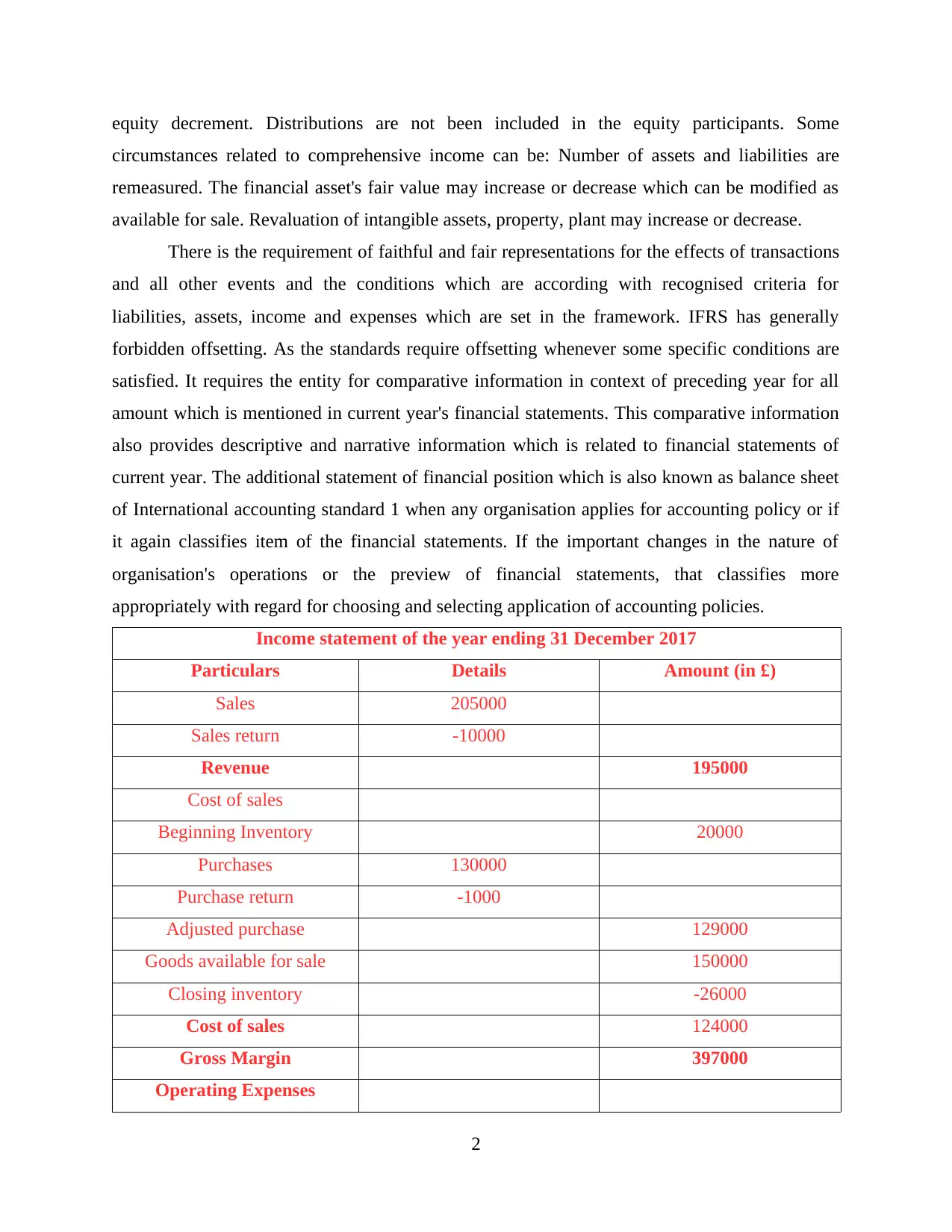
equity decrement. Distributions are not been included in the equity participants. Some
circumstances related to comprehensive income can be: Number of assets and liabilities are
remeasured. The financial asset's fair value may increase or decrease which can be modified as
available for sale. Revaluation of intangible assets, property, plant may increase or decrease.
There is the requirement of faithful and fair representations for the effects of transactions
and all other events and the conditions which are according with recognised criteria for
liabilities, assets, income and expenses which are set in the framework. IFRS has generally
forbidden offsetting. As the standards require offsetting whenever some specific conditions are
satisfied. It requires the entity for comparative information in context of preceding year for all
amount which is mentioned in current year's financial statements. This comparative information
also provides descriptive and narrative information which is related to financial statements of
current year. The additional statement of financial position which is also known as balance sheet
of International accounting standard 1 when any organisation applies for accounting policy or if
it again classifies item of the financial statements. If the important changes in the nature of
organisation's operations or the preview of financial statements, that classifies more
appropriately with regard for choosing and selecting application of accounting policies.
Income statement of the year ending 31 December 2017
Particulars Details Amount (in £)
Sales 205000
Sales return -10000
Revenue 195000
Cost of sales
Beginning Inventory 20000
Purchases 130000
Purchase return -1000
Adjusted purchase 129000
Goods available for sale 150000
Closing inventory -26000
Cost of sales 124000
Gross Margin 397000
Operating Expenses
2
circumstances related to comprehensive income can be: Number of assets and liabilities are
remeasured. The financial asset's fair value may increase or decrease which can be modified as
available for sale. Revaluation of intangible assets, property, plant may increase or decrease.
There is the requirement of faithful and fair representations for the effects of transactions
and all other events and the conditions which are according with recognised criteria for
liabilities, assets, income and expenses which are set in the framework. IFRS has generally
forbidden offsetting. As the standards require offsetting whenever some specific conditions are
satisfied. It requires the entity for comparative information in context of preceding year for all
amount which is mentioned in current year's financial statements. This comparative information
also provides descriptive and narrative information which is related to financial statements of
current year. The additional statement of financial position which is also known as balance sheet
of International accounting standard 1 when any organisation applies for accounting policy or if
it again classifies item of the financial statements. If the important changes in the nature of
organisation's operations or the preview of financial statements, that classifies more
appropriately with regard for choosing and selecting application of accounting policies.
Income statement of the year ending 31 December 2017
Particulars Details Amount (in £)
Sales 205000
Sales return -10000
Revenue 195000
Cost of sales
Beginning Inventory 20000
Purchases 130000
Purchase return -1000
Adjusted purchase 129000
Goods available for sale 150000
Closing inventory -26000
Cost of sales 124000
Gross Margin 397000
Operating Expenses
2
Paraphrase This Document
Need a fresh take? Get an instant paraphrase of this document with our AI Paraphraser
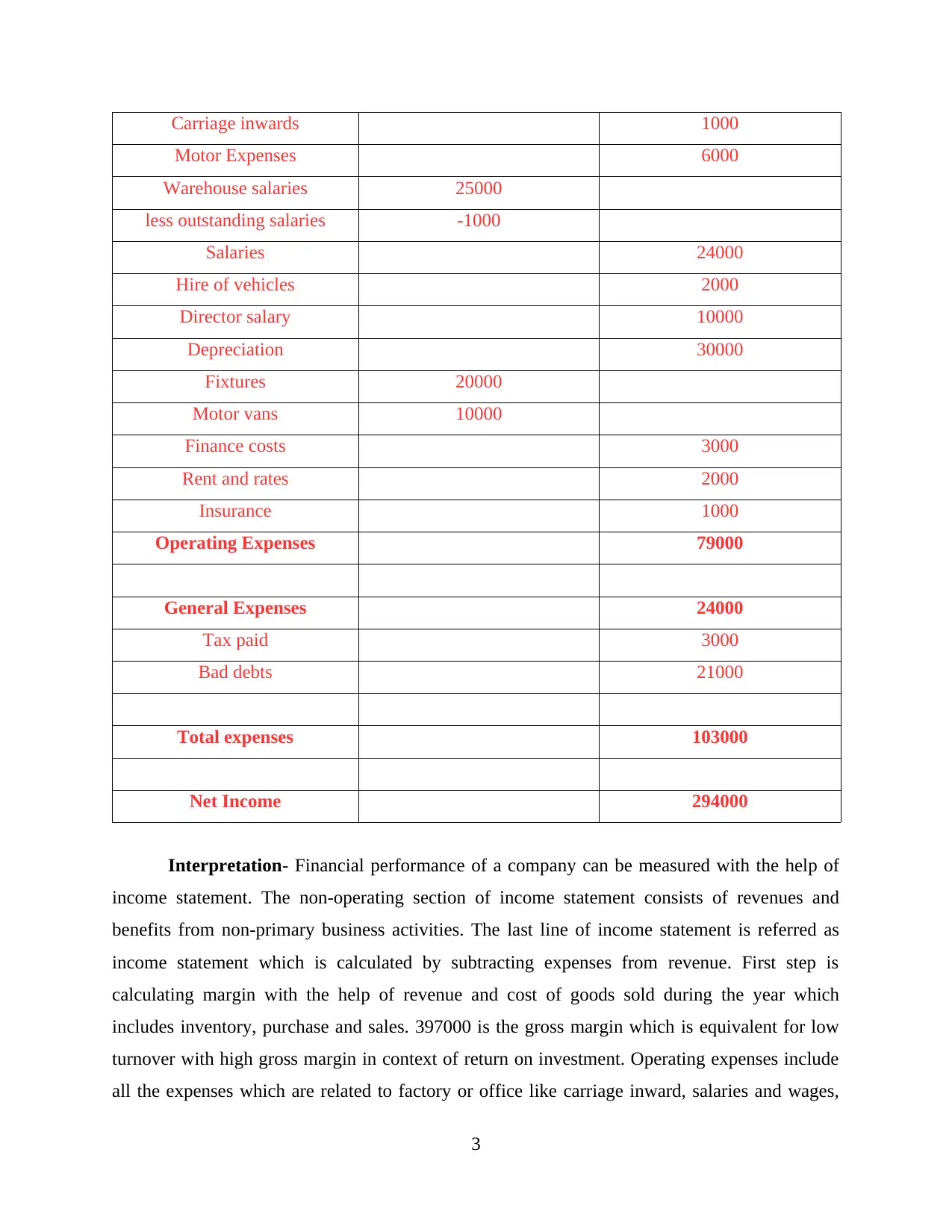
Carriage inwards 1000
Motor Expenses 6000
Warehouse salaries 25000
less outstanding salaries -1000
Salaries 24000
Hire of vehicles 2000
Director salary 10000
Depreciation 30000
Fixtures 20000
Motor vans 10000
Finance costs 3000
Rent and rates 2000
Insurance 1000
Operating Expenses 79000
General Expenses 24000
Tax paid 3000
Bad debts 21000
Total expenses 103000
Net Income 294000
Interpretation- Financial performance of a company can be measured with the help of
income statement. The non-operating section of income statement consists of revenues and
benefits from non-primary business activities. The last line of income statement is referred as
income statement which is calculated by subtracting expenses from revenue. First step is
calculating margin with the help of revenue and cost of goods sold during the year which
includes inventory, purchase and sales. 397000 is the gross margin which is equivalent for low
turnover with high gross margin in context of return on investment. Operating expenses include
all the expenses which are related to factory or office like carriage inward, salaries and wages,
3
Motor Expenses 6000
Warehouse salaries 25000
less outstanding salaries -1000
Salaries 24000
Hire of vehicles 2000
Director salary 10000
Depreciation 30000
Fixtures 20000
Motor vans 10000
Finance costs 3000
Rent and rates 2000
Insurance 1000
Operating Expenses 79000
General Expenses 24000
Tax paid 3000
Bad debts 21000
Total expenses 103000
Net Income 294000
Interpretation- Financial performance of a company can be measured with the help of
income statement. The non-operating section of income statement consists of revenues and
benefits from non-primary business activities. The last line of income statement is referred as
income statement which is calculated by subtracting expenses from revenue. First step is
calculating margin with the help of revenue and cost of goods sold during the year which
includes inventory, purchase and sales. 397000 is the gross margin which is equivalent for low
turnover with high gross margin in context of return on investment. Operating expenses include
all the expenses which are related to factory or office like carriage inward, salaries and wages,
3
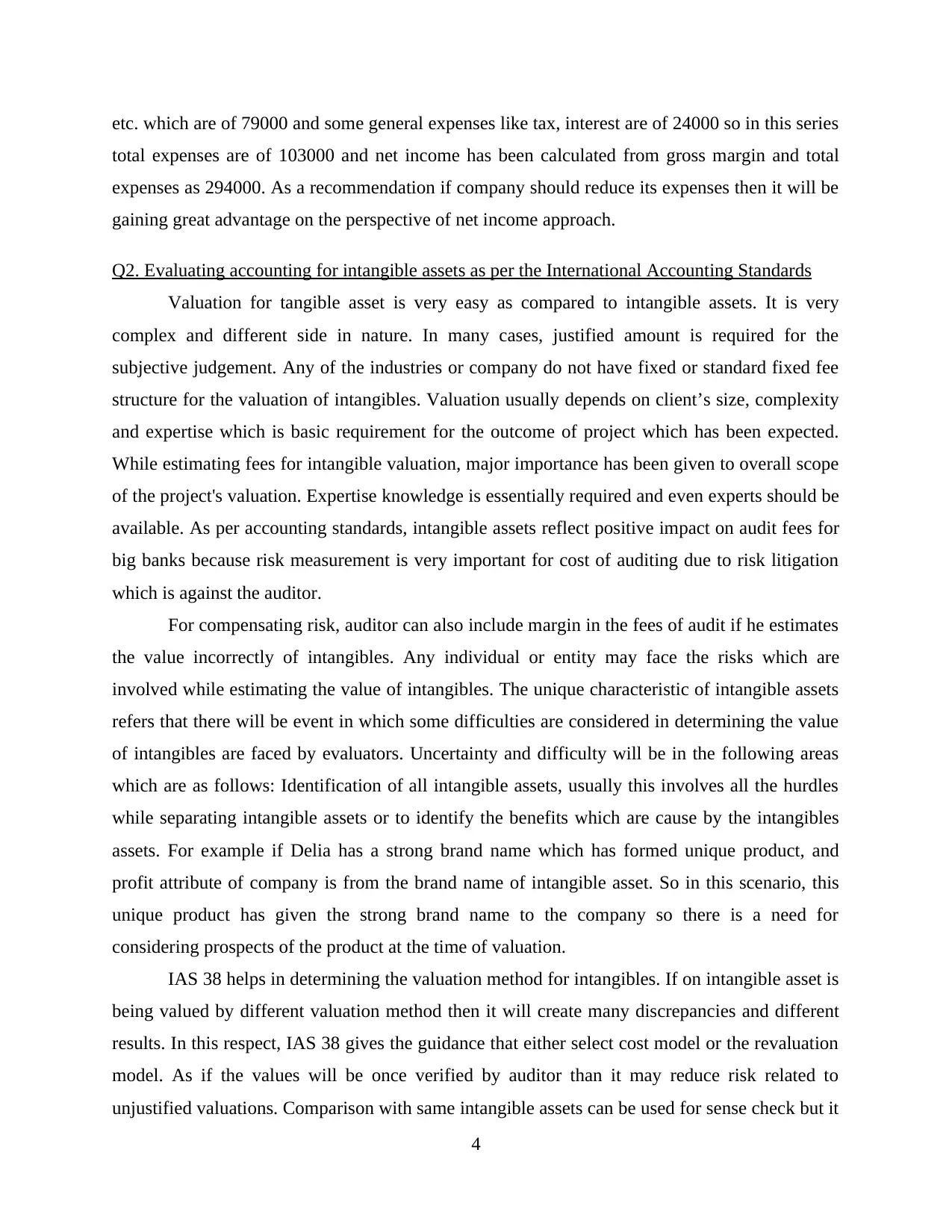
etc. which are of 79000 and some general expenses like tax, interest are of 24000 so in this series
total expenses are of 103000 and net income has been calculated from gross margin and total
expenses as 294000. As a recommendation if company should reduce its expenses then it will be
gaining great advantage on the perspective of net income approach.
Q2. Evaluating accounting for intangible assets as per the International Accounting Standards
Valuation for tangible asset is very easy as compared to intangible assets. It is very
complex and different side in nature. In many cases, justified amount is required for the
subjective judgement. Any of the industries or company do not have fixed or standard fixed fee
structure for the valuation of intangibles. Valuation usually depends on client’s size, complexity
and expertise which is basic requirement for the outcome of project which has been expected.
While estimating fees for intangible valuation, major importance has been given to overall scope
of the project's valuation. Expertise knowledge is essentially required and even experts should be
available. As per accounting standards, intangible assets reflect positive impact on audit fees for
big banks because risk measurement is very important for cost of auditing due to risk litigation
which is against the auditor.
For compensating risk, auditor can also include margin in the fees of audit if he estimates
the value incorrectly of intangibles. Any individual or entity may face the risks which are
involved while estimating the value of intangibles. The unique characteristic of intangible assets
refers that there will be event in which some difficulties are considered in determining the value
of intangibles are faced by evaluators. Uncertainty and difficulty will be in the following areas
which are as follows: Identification of all intangible assets, usually this involves all the hurdles
while separating intangible assets or to identify the benefits which are cause by the intangibles
assets. For example if Delia has a strong brand name which has formed unique product, and
profit attribute of company is from the brand name of intangible asset. So in this scenario, this
unique product has given the strong brand name to the company so there is a need for
considering prospects of the product at the time of valuation.
IAS 38 helps in determining the valuation method for intangibles. If on intangible asset is
being valued by different valuation method then it will create many discrepancies and different
results. In this respect, IAS 38 gives the guidance that either select cost model or the revaluation
model. As if the values will be once verified by auditor than it may reduce risk related to
unjustified valuations. Comparison with same intangible assets can be used for sense check but it
4
total expenses are of 103000 and net income has been calculated from gross margin and total
expenses as 294000. As a recommendation if company should reduce its expenses then it will be
gaining great advantage on the perspective of net income approach.
Q2. Evaluating accounting for intangible assets as per the International Accounting Standards
Valuation for tangible asset is very easy as compared to intangible assets. It is very
complex and different side in nature. In many cases, justified amount is required for the
subjective judgement. Any of the industries or company do not have fixed or standard fixed fee
structure for the valuation of intangibles. Valuation usually depends on client’s size, complexity
and expertise which is basic requirement for the outcome of project which has been expected.
While estimating fees for intangible valuation, major importance has been given to overall scope
of the project's valuation. Expertise knowledge is essentially required and even experts should be
available. As per accounting standards, intangible assets reflect positive impact on audit fees for
big banks because risk measurement is very important for cost of auditing due to risk litigation
which is against the auditor.
For compensating risk, auditor can also include margin in the fees of audit if he estimates
the value incorrectly of intangibles. Any individual or entity may face the risks which are
involved while estimating the value of intangibles. The unique characteristic of intangible assets
refers that there will be event in which some difficulties are considered in determining the value
of intangibles are faced by evaluators. Uncertainty and difficulty will be in the following areas
which are as follows: Identification of all intangible assets, usually this involves all the hurdles
while separating intangible assets or to identify the benefits which are cause by the intangibles
assets. For example if Delia has a strong brand name which has formed unique product, and
profit attribute of company is from the brand name of intangible asset. So in this scenario, this
unique product has given the strong brand name to the company so there is a need for
considering prospects of the product at the time of valuation.
IAS 38 helps in determining the valuation method for intangibles. If on intangible asset is
being valued by different valuation method then it will create many discrepancies and different
results. In this respect, IAS 38 gives the guidance that either select cost model or the revaluation
model. As if the values will be once verified by auditor than it may reduce risk related to
unjustified valuations. Comparison with same intangible assets can be used for sense check but it
4
⊘ This is a preview!⊘
Do you want full access?
Subscribe today to unlock all pages.

Trusted by 1+ million students worldwide
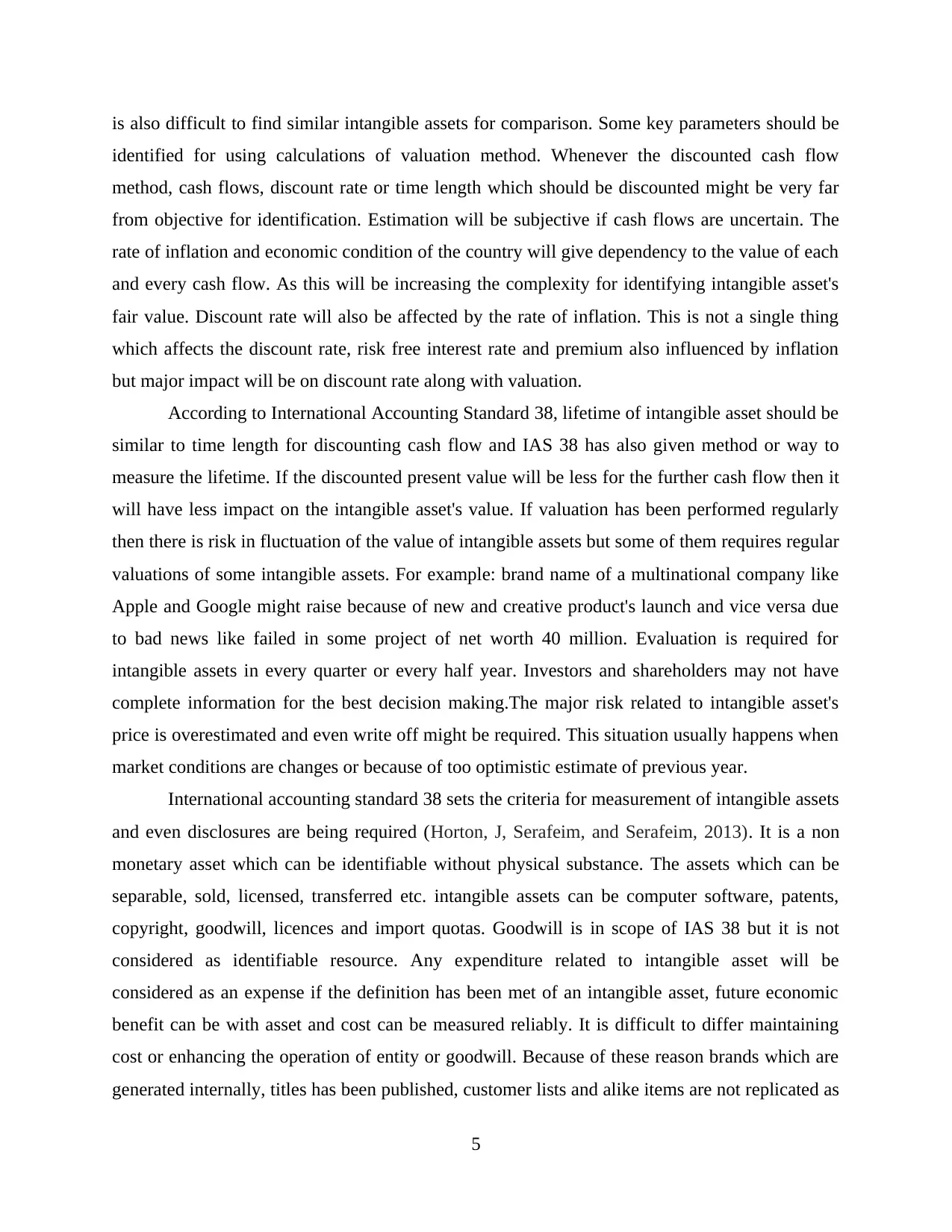
is also difficult to find similar intangible assets for comparison. Some key parameters should be
identified for using calculations of valuation method. Whenever the discounted cash flow
method, cash flows, discount rate or time length which should be discounted might be very far
from objective for identification. Estimation will be subjective if cash flows are uncertain. The
rate of inflation and economic condition of the country will give dependency to the value of each
and every cash flow. As this will be increasing the complexity for identifying intangible asset's
fair value. Discount rate will also be affected by the rate of inflation. This is not a single thing
which affects the discount rate, risk free interest rate and premium also influenced by inflation
but major impact will be on discount rate along with valuation.
According to International Accounting Standard 38, lifetime of intangible asset should be
similar to time length for discounting cash flow and IAS 38 has also given method or way to
measure the lifetime. If the discounted present value will be less for the further cash flow then it
will have less impact on the intangible asset's value. If valuation has been performed regularly
then there is risk in fluctuation of the value of intangible assets but some of them requires regular
valuations of some intangible assets. For example: brand name of a multinational company like
Apple and Google might raise because of new and creative product's launch and vice versa due
to bad news like failed in some project of net worth 40 million. Evaluation is required for
intangible assets in every quarter or every half year. Investors and shareholders may not have
complete information for the best decision making.The major risk related to intangible asset's
price is overestimated and even write off might be required. This situation usually happens when
market conditions are changes or because of too optimistic estimate of previous year.
International accounting standard 38 sets the criteria for measurement of intangible assets
and even disclosures are being required (Horton, J, Serafeim, and Serafeim, 2013). It is a non
monetary asset which can be identifiable without physical substance. The assets which can be
separable, sold, licensed, transferred etc. intangible assets can be computer software, patents,
copyright, goodwill, licences and import quotas. Goodwill is in scope of IAS 38 but it is not
considered as identifiable resource. Any expenditure related to intangible asset will be
considered as an expense if the definition has been met of an intangible asset, future economic
benefit can be with asset and cost can be measured reliably. It is difficult to differ maintaining
cost or enhancing the operation of entity or goodwill. Because of these reason brands which are
generated internally, titles has been published, customer lists and alike items are not replicated as
5
identified for using calculations of valuation method. Whenever the discounted cash flow
method, cash flows, discount rate or time length which should be discounted might be very far
from objective for identification. Estimation will be subjective if cash flows are uncertain. The
rate of inflation and economic condition of the country will give dependency to the value of each
and every cash flow. As this will be increasing the complexity for identifying intangible asset's
fair value. Discount rate will also be affected by the rate of inflation. This is not a single thing
which affects the discount rate, risk free interest rate and premium also influenced by inflation
but major impact will be on discount rate along with valuation.
According to International Accounting Standard 38, lifetime of intangible asset should be
similar to time length for discounting cash flow and IAS 38 has also given method or way to
measure the lifetime. If the discounted present value will be less for the further cash flow then it
will have less impact on the intangible asset's value. If valuation has been performed regularly
then there is risk in fluctuation of the value of intangible assets but some of them requires regular
valuations of some intangible assets. For example: brand name of a multinational company like
Apple and Google might raise because of new and creative product's launch and vice versa due
to bad news like failed in some project of net worth 40 million. Evaluation is required for
intangible assets in every quarter or every half year. Investors and shareholders may not have
complete information for the best decision making.The major risk related to intangible asset's
price is overestimated and even write off might be required. This situation usually happens when
market conditions are changes or because of too optimistic estimate of previous year.
International accounting standard 38 sets the criteria for measurement of intangible assets
and even disclosures are being required (Horton, J, Serafeim, and Serafeim, 2013). It is a non
monetary asset which can be identifiable without physical substance. The assets which can be
separable, sold, licensed, transferred etc. intangible assets can be computer software, patents,
copyright, goodwill, licences and import quotas. Goodwill is in scope of IAS 38 but it is not
considered as identifiable resource. Any expenditure related to intangible asset will be
considered as an expense if the definition has been met of an intangible asset, future economic
benefit can be with asset and cost can be measured reliably. It is difficult to differ maintaining
cost or enhancing the operation of entity or goodwill. Because of these reason brands which are
generated internally, titles has been published, customer lists and alike items are not replicated as
5
Paraphrase This Document
Need a fresh take? Get an instant paraphrase of this document with our AI Paraphraser
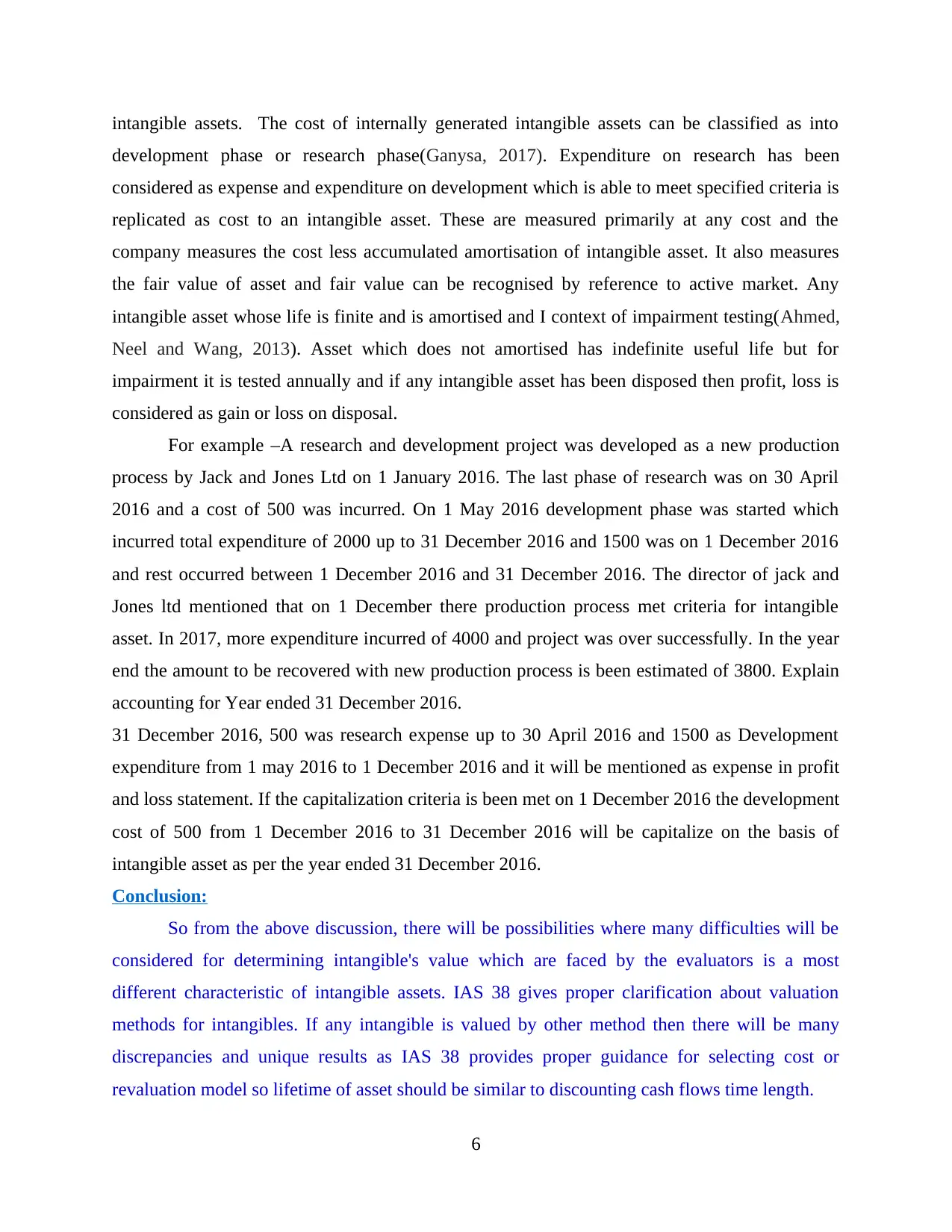
intangible assets. The cost of internally generated intangible assets can be classified as into
development phase or research phase(Ganysa, 2017). Expenditure on research has been
considered as expense and expenditure on development which is able to meet specified criteria is
replicated as cost to an intangible asset. These are measured primarily at any cost and the
company measures the cost less accumulated amortisation of intangible asset. It also measures
the fair value of asset and fair value can be recognised by reference to active market. Any
intangible asset whose life is finite and is amortised and I context of impairment testing(Ahmed,
Neel and Wang, 2013). Asset which does not amortised has indefinite useful life but for
impairment it is tested annually and if any intangible asset has been disposed then profit, loss is
considered as gain or loss on disposal.
For example –A research and development project was developed as a new production
process by Jack and Jones Ltd on 1 January 2016. The last phase of research was on 30 April
2016 and a cost of 500 was incurred. On 1 May 2016 development phase was started which
incurred total expenditure of 2000 up to 31 December 2016 and 1500 was on 1 December 2016
and rest occurred between 1 December 2016 and 31 December 2016. The director of jack and
Jones ltd mentioned that on 1 December there production process met criteria for intangible
asset. In 2017, more expenditure incurred of 4000 and project was over successfully. In the year
end the amount to be recovered with new production process is been estimated of 3800. Explain
accounting for Year ended 31 December 2016.
31 December 2016, 500 was research expense up to 30 April 2016 and 1500 as Development
expenditure from 1 may 2016 to 1 December 2016 and it will be mentioned as expense in profit
and loss statement. If the capitalization criteria is been met on 1 December 2016 the development
cost of 500 from 1 December 2016 to 31 December 2016 will be capitalize on the basis of
intangible asset as per the year ended 31 December 2016.
Conclusion:
So from the above discussion, there will be possibilities where many difficulties will be
considered for determining intangible's value which are faced by the evaluators is a most
different characteristic of intangible assets. IAS 38 gives proper clarification about valuation
methods for intangibles. If any intangible is valued by other method then there will be many
discrepancies and unique results as IAS 38 provides proper guidance for selecting cost or
revaluation model so lifetime of asset should be similar to discounting cash flows time length.
6
development phase or research phase(Ganysa, 2017). Expenditure on research has been
considered as expense and expenditure on development which is able to meet specified criteria is
replicated as cost to an intangible asset. These are measured primarily at any cost and the
company measures the cost less accumulated amortisation of intangible asset. It also measures
the fair value of asset and fair value can be recognised by reference to active market. Any
intangible asset whose life is finite and is amortised and I context of impairment testing(Ahmed,
Neel and Wang, 2013). Asset which does not amortised has indefinite useful life but for
impairment it is tested annually and if any intangible asset has been disposed then profit, loss is
considered as gain or loss on disposal.
For example –A research and development project was developed as a new production
process by Jack and Jones Ltd on 1 January 2016. The last phase of research was on 30 April
2016 and a cost of 500 was incurred. On 1 May 2016 development phase was started which
incurred total expenditure of 2000 up to 31 December 2016 and 1500 was on 1 December 2016
and rest occurred between 1 December 2016 and 31 December 2016. The director of jack and
Jones ltd mentioned that on 1 December there production process met criteria for intangible
asset. In 2017, more expenditure incurred of 4000 and project was over successfully. In the year
end the amount to be recovered with new production process is been estimated of 3800. Explain
accounting for Year ended 31 December 2016.
31 December 2016, 500 was research expense up to 30 April 2016 and 1500 as Development
expenditure from 1 may 2016 to 1 December 2016 and it will be mentioned as expense in profit
and loss statement. If the capitalization criteria is been met on 1 December 2016 the development
cost of 500 from 1 December 2016 to 31 December 2016 will be capitalize on the basis of
intangible asset as per the year ended 31 December 2016.
Conclusion:
So from the above discussion, there will be possibilities where many difficulties will be
considered for determining intangible's value which are faced by the evaluators is a most
different characteristic of intangible assets. IAS 38 gives proper clarification about valuation
methods for intangibles. If any intangible is valued by other method then there will be many
discrepancies and unique results as IAS 38 provides proper guidance for selecting cost or
revaluation model so lifetime of asset should be similar to discounting cash flows time length.
6
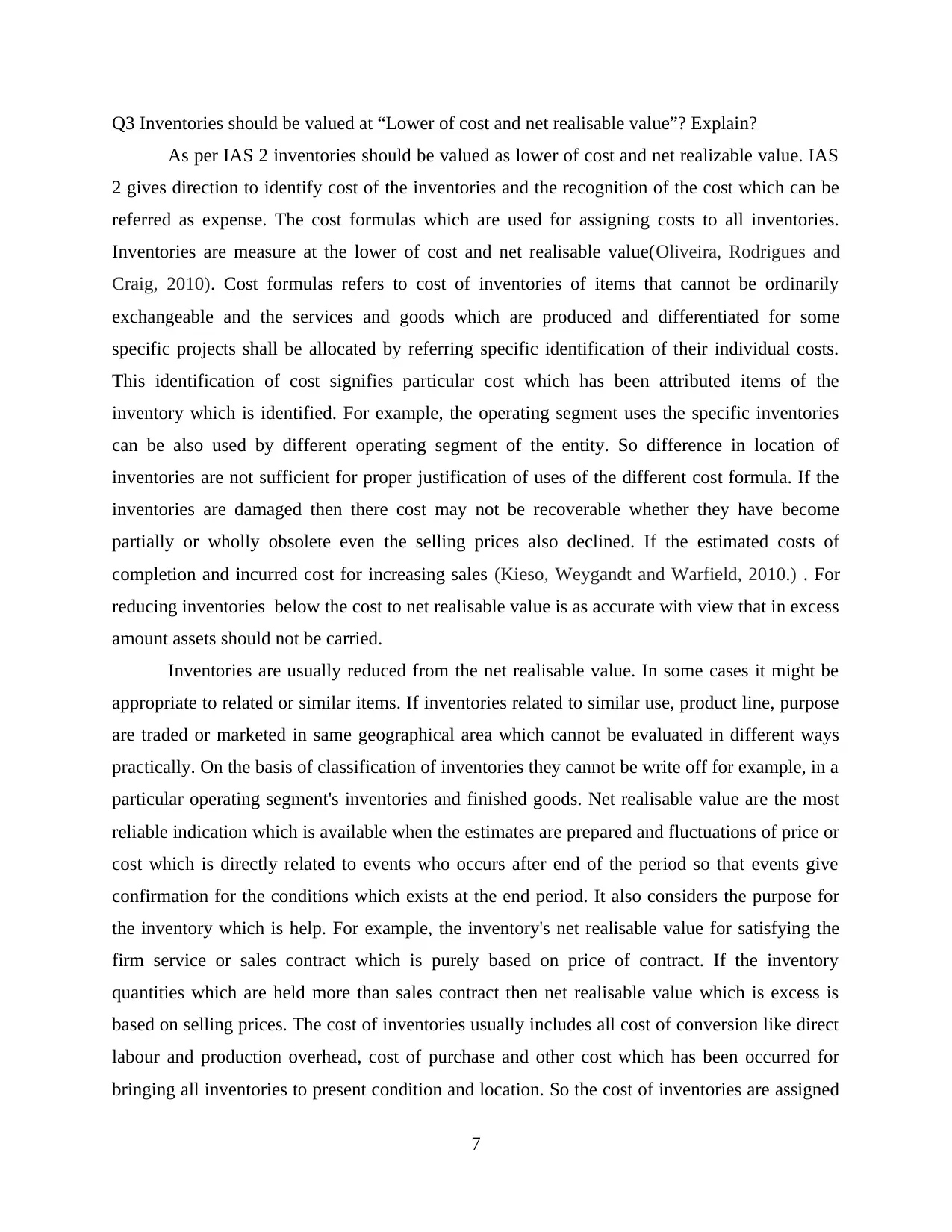
Q3 Inventories should be valued at “Lower of cost and net realisable value”? Explain?
As per IAS 2 inventories should be valued as lower of cost and net realizable value. IAS
2 gives direction to identify cost of the inventories and the recognition of the cost which can be
referred as expense. The cost formulas which are used for assigning costs to all inventories.
Inventories are measure at the lower of cost and net realisable value(Oliveira, Rodrigues and
Craig, 2010). Cost formulas refers to cost of inventories of items that cannot be ordinarily
exchangeable and the services and goods which are produced and differentiated for some
specific projects shall be allocated by referring specific identification of their individual costs.
This identification of cost signifies particular cost which has been attributed items of the
inventory which is identified. For example, the operating segment uses the specific inventories
can be also used by different operating segment of the entity. So difference in location of
inventories are not sufficient for proper justification of uses of the different cost formula. If the
inventories are damaged then there cost may not be recoverable whether they have become
partially or wholly obsolete even the selling prices also declined. If the estimated costs of
completion and incurred cost for increasing sales (Kieso, Weygandt and Warfield, 2010.) . For
reducing inventories below the cost to net realisable value is as accurate with view that in excess
amount assets should not be carried.
Inventories are usually reduced from the net realisable value. In some cases it might be
appropriate to related or similar items. If inventories related to similar use, product line, purpose
are traded or marketed in same geographical area which cannot be evaluated in different ways
practically. On the basis of classification of inventories they cannot be write off for example, in a
particular operating segment's inventories and finished goods. Net realisable value are the most
reliable indication which is available when the estimates are prepared and fluctuations of price or
cost which is directly related to events who occurs after end of the period so that events give
confirmation for the conditions which exists at the end period. It also considers the purpose for
the inventory which is help. For example, the inventory's net realisable value for satisfying the
firm service or sales contract which is purely based on price of contract. If the inventory
quantities which are held more than sales contract then net realisable value which is excess is
based on selling prices. The cost of inventories usually includes all cost of conversion like direct
labour and production overhead, cost of purchase and other cost which has been occurred for
bringing all inventories to present condition and location. So the cost of inventories are assigned
7
As per IAS 2 inventories should be valued as lower of cost and net realizable value. IAS
2 gives direction to identify cost of the inventories and the recognition of the cost which can be
referred as expense. The cost formulas which are used for assigning costs to all inventories.
Inventories are measure at the lower of cost and net realisable value(Oliveira, Rodrigues and
Craig, 2010). Cost formulas refers to cost of inventories of items that cannot be ordinarily
exchangeable and the services and goods which are produced and differentiated for some
specific projects shall be allocated by referring specific identification of their individual costs.
This identification of cost signifies particular cost which has been attributed items of the
inventory which is identified. For example, the operating segment uses the specific inventories
can be also used by different operating segment of the entity. So difference in location of
inventories are not sufficient for proper justification of uses of the different cost formula. If the
inventories are damaged then there cost may not be recoverable whether they have become
partially or wholly obsolete even the selling prices also declined. If the estimated costs of
completion and incurred cost for increasing sales (Kieso, Weygandt and Warfield, 2010.) . For
reducing inventories below the cost to net realisable value is as accurate with view that in excess
amount assets should not be carried.
Inventories are usually reduced from the net realisable value. In some cases it might be
appropriate to related or similar items. If inventories related to similar use, product line, purpose
are traded or marketed in same geographical area which cannot be evaluated in different ways
practically. On the basis of classification of inventories they cannot be write off for example, in a
particular operating segment's inventories and finished goods. Net realisable value are the most
reliable indication which is available when the estimates are prepared and fluctuations of price or
cost which is directly related to events who occurs after end of the period so that events give
confirmation for the conditions which exists at the end period. It also considers the purpose for
the inventory which is help. For example, the inventory's net realisable value for satisfying the
firm service or sales contract which is purely based on price of contract. If the inventory
quantities which are held more than sales contract then net realisable value which is excess is
based on selling prices. The cost of inventories usually includes all cost of conversion like direct
labour and production overhead, cost of purchase and other cost which has been occurred for
bringing all inventories to present condition and location. So the cost of inventories are assigned
7
⊘ This is a preview!⊘
Do you want full access?
Subscribe today to unlock all pages.

Trusted by 1+ million students worldwide
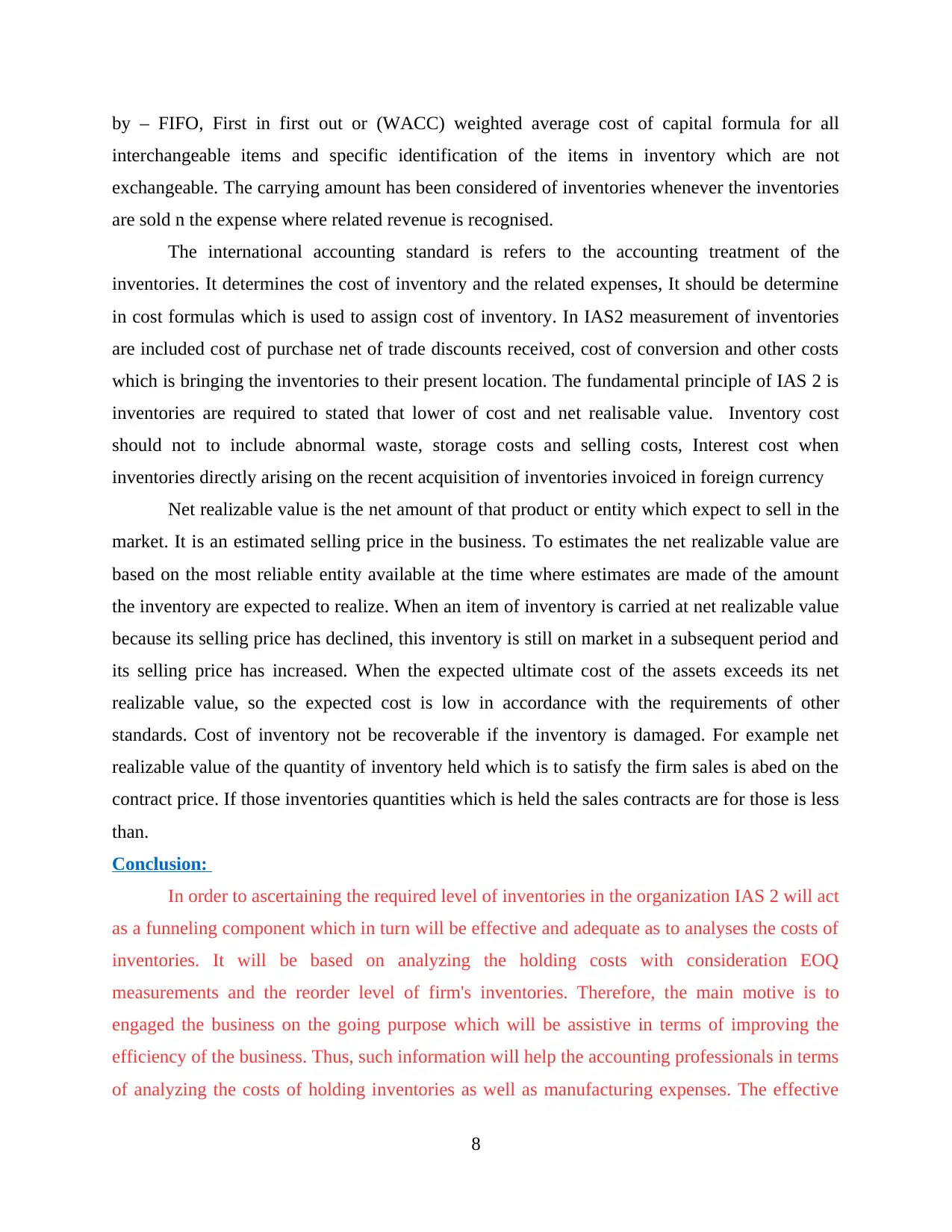
by – FIFO, First in first out or (WACC) weighted average cost of capital formula for all
interchangeable items and specific identification of the items in inventory which are not
exchangeable. The carrying amount has been considered of inventories whenever the inventories
are sold n the expense where related revenue is recognised.
The international accounting standard is refers to the accounting treatment of the
inventories. It determines the cost of inventory and the related expenses, It should be determine
in cost formulas which is used to assign cost of inventory. In IAS2 measurement of inventories
are included cost of purchase net of trade discounts received, cost of conversion and other costs
which is bringing the inventories to their present location. The fundamental principle of IAS 2 is
inventories are required to stated that lower of cost and net realisable value. Inventory cost
should not to include abnormal waste, storage costs and selling costs, Interest cost when
inventories directly arising on the recent acquisition of inventories invoiced in foreign currency
Net realizable value is the net amount of that product or entity which expect to sell in the
market. It is an estimated selling price in the business. To estimates the net realizable value are
based on the most reliable entity available at the time where estimates are made of the amount
the inventory are expected to realize. When an item of inventory is carried at net realizable value
because its selling price has declined, this inventory is still on market in a subsequent period and
its selling price has increased. When the expected ultimate cost of the assets exceeds its net
realizable value, so the expected cost is low in accordance with the requirements of other
standards. Cost of inventory not be recoverable if the inventory is damaged. For example net
realizable value of the quantity of inventory held which is to satisfy the firm sales is abed on the
contract price. If those inventories quantities which is held the sales contracts are for those is less
than.
Conclusion:
In order to ascertaining the required level of inventories in the organization IAS 2 will act
as a funneling component which in turn will be effective and adequate as to analyses the costs of
inventories. It will be based on analyzing the holding costs with consideration EOQ
measurements and the reorder level of firm's inventories. Therefore, the main motive is to
engaged the business on the going purpose which will be assistive in terms of improving the
efficiency of the business. Thus, such information will help the accounting professionals in terms
of analyzing the costs of holding inventories as well as manufacturing expenses. The effective
8
interchangeable items and specific identification of the items in inventory which are not
exchangeable. The carrying amount has been considered of inventories whenever the inventories
are sold n the expense where related revenue is recognised.
The international accounting standard is refers to the accounting treatment of the
inventories. It determines the cost of inventory and the related expenses, It should be determine
in cost formulas which is used to assign cost of inventory. In IAS2 measurement of inventories
are included cost of purchase net of trade discounts received, cost of conversion and other costs
which is bringing the inventories to their present location. The fundamental principle of IAS 2 is
inventories are required to stated that lower of cost and net realisable value. Inventory cost
should not to include abnormal waste, storage costs and selling costs, Interest cost when
inventories directly arising on the recent acquisition of inventories invoiced in foreign currency
Net realizable value is the net amount of that product or entity which expect to sell in the
market. It is an estimated selling price in the business. To estimates the net realizable value are
based on the most reliable entity available at the time where estimates are made of the amount
the inventory are expected to realize. When an item of inventory is carried at net realizable value
because its selling price has declined, this inventory is still on market in a subsequent period and
its selling price has increased. When the expected ultimate cost of the assets exceeds its net
realizable value, so the expected cost is low in accordance with the requirements of other
standards. Cost of inventory not be recoverable if the inventory is damaged. For example net
realizable value of the quantity of inventory held which is to satisfy the firm sales is abed on the
contract price. If those inventories quantities which is held the sales contracts are for those is less
than.
Conclusion:
In order to ascertaining the required level of inventories in the organization IAS 2 will act
as a funneling component which in turn will be effective and adequate as to analyses the costs of
inventories. It will be based on analyzing the holding costs with consideration EOQ
measurements and the reorder level of firm's inventories. Therefore, the main motive is to
engaged the business on the going purpose which will be assistive in terms of improving the
efficiency of the business. Thus, such information will help the accounting professionals in terms
of analyzing the costs of holding inventories as well as manufacturing expenses. The effective
8
Paraphrase This Document
Need a fresh take? Get an instant paraphrase of this document with our AI Paraphraser
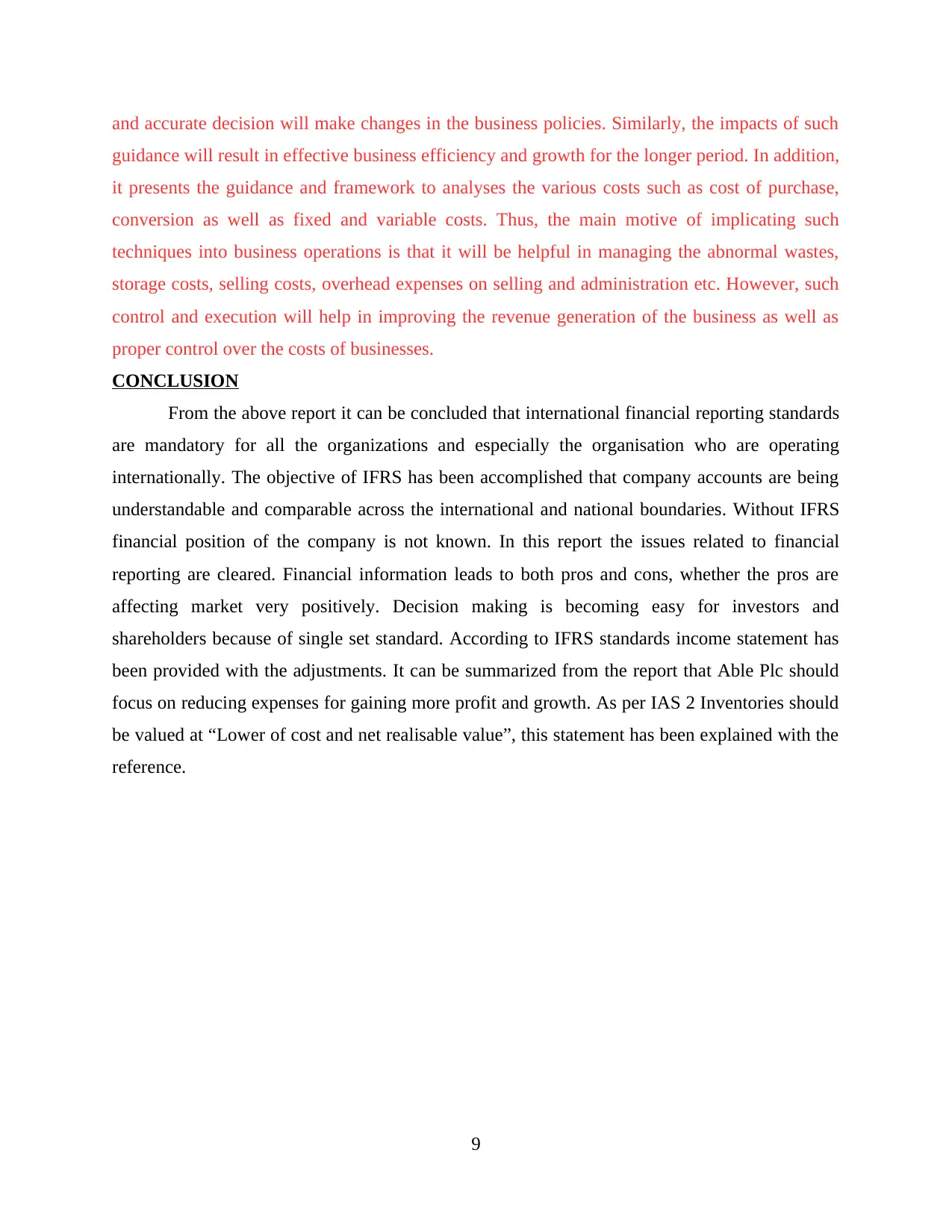
and accurate decision will make changes in the business policies. Similarly, the impacts of such
guidance will result in effective business efficiency and growth for the longer period. In addition,
it presents the guidance and framework to analyses the various costs such as cost of purchase,
conversion as well as fixed and variable costs. Thus, the main motive of implicating such
techniques into business operations is that it will be helpful in managing the abnormal wastes,
storage costs, selling costs, overhead expenses on selling and administration etc. However, such
control and execution will help in improving the revenue generation of the business as well as
proper control over the costs of businesses.
CONCLUSION
From the above report it can be concluded that international financial reporting standards
are mandatory for all the organizations and especially the organisation who are operating
internationally. The objective of IFRS has been accomplished that company accounts are being
understandable and comparable across the international and national boundaries. Without IFRS
financial position of the company is not known. In this report the issues related to financial
reporting are cleared. Financial information leads to both pros and cons, whether the pros are
affecting market very positively. Decision making is becoming easy for investors and
shareholders because of single set standard. According to IFRS standards income statement has
been provided with the adjustments. It can be summarized from the report that Able Plc should
focus on reducing expenses for gaining more profit and growth. As per IAS 2 Inventories should
be valued at “Lower of cost and net realisable value”, this statement has been explained with the
reference.
9
guidance will result in effective business efficiency and growth for the longer period. In addition,
it presents the guidance and framework to analyses the various costs such as cost of purchase,
conversion as well as fixed and variable costs. Thus, the main motive of implicating such
techniques into business operations is that it will be helpful in managing the abnormal wastes,
storage costs, selling costs, overhead expenses on selling and administration etc. However, such
control and execution will help in improving the revenue generation of the business as well as
proper control over the costs of businesses.
CONCLUSION
From the above report it can be concluded that international financial reporting standards
are mandatory for all the organizations and especially the organisation who are operating
internationally. The objective of IFRS has been accomplished that company accounts are being
understandable and comparable across the international and national boundaries. Without IFRS
financial position of the company is not known. In this report the issues related to financial
reporting are cleared. Financial information leads to both pros and cons, whether the pros are
affecting market very positively. Decision making is becoming easy for investors and
shareholders because of single set standard. According to IFRS standards income statement has
been provided with the adjustments. It can be summarized from the report that Able Plc should
focus on reducing expenses for gaining more profit and growth. As per IAS 2 Inventories should
be valued at “Lower of cost and net realisable value”, this statement has been explained with the
reference.
9
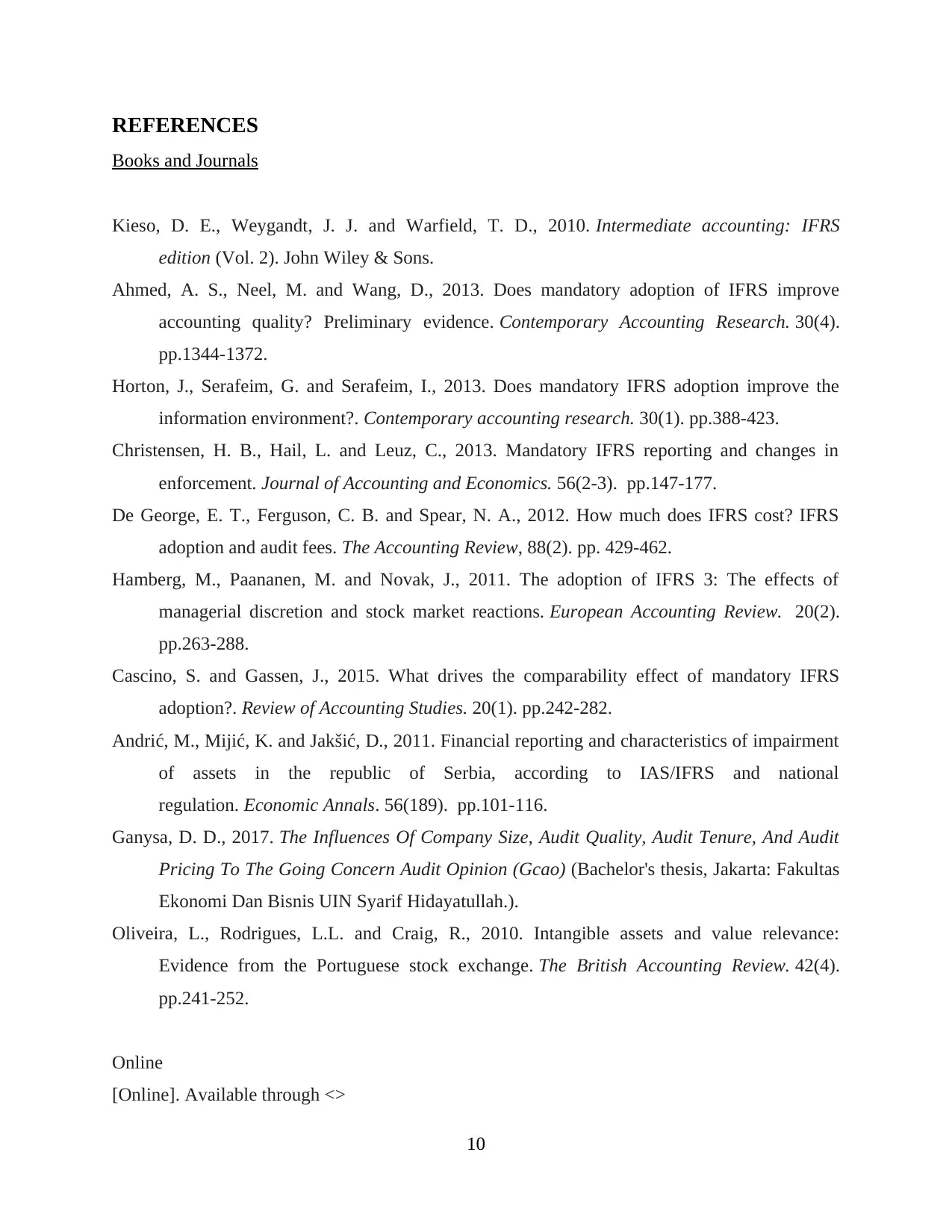
REFERENCES
Books and Journals
Kieso, D. E., Weygandt, J. J. and Warfield, T. D., 2010. Intermediate accounting: IFRS
edition (Vol. 2). John Wiley & Sons.
Ahmed, A. S., Neel, M. and Wang, D., 2013. Does mandatory adoption of IFRS improve
accounting quality? Preliminary evidence. Contemporary Accounting Research. 30(4).
pp.1344-1372.
Horton, J., Serafeim, G. and Serafeim, I., 2013. Does mandatory IFRS adoption improve the
information environment?. Contemporary accounting research. 30(1). pp.388-423.
Christensen, H. B., Hail, L. and Leuz, C., 2013. Mandatory IFRS reporting and changes in
enforcement. Journal of Accounting and Economics. 56(2-3). pp.147-177.
De George, E. T., Ferguson, C. B. and Spear, N. A., 2012. How much does IFRS cost? IFRS
adoption and audit fees. The Accounting Review, 88(2). pp. 429-462.
Hamberg, M., Paananen, M. and Novak, J., 2011. The adoption of IFRS 3: The effects of
managerial discretion and stock market reactions. European Accounting Review. 20(2).
pp.263-288.
Cascino, S. and Gassen, J., 2015. What drives the comparability effect of mandatory IFRS
adoption?. Review of Accounting Studies. 20(1). pp.242-282.
Andrić, M., Mijić, K. and Jakšić, D., 2011. Financial reporting and characteristics of impairment
of assets in the republic of Serbia, according to IAS/IFRS and national
regulation. Economic Annals. 56(189). pp.101-116.
Ganysa, D. D., 2017. The Influences Of Company Size, Audit Quality, Audit Tenure, And Audit
Pricing To The Going Concern Audit Opinion (Gcao) (Bachelor's thesis, Jakarta: Fakultas
Ekonomi Dan Bisnis UIN Syarif Hidayatullah.).
Oliveira, L., Rodrigues, L.L. and Craig, R., 2010. Intangible assets and value relevance:
Evidence from the Portuguese stock exchange. The British Accounting Review. 42(4).
pp.241-252.
Online
[Online]. Available through <>
10
Books and Journals
Kieso, D. E., Weygandt, J. J. and Warfield, T. D., 2010. Intermediate accounting: IFRS
edition (Vol. 2). John Wiley & Sons.
Ahmed, A. S., Neel, M. and Wang, D., 2013. Does mandatory adoption of IFRS improve
accounting quality? Preliminary evidence. Contemporary Accounting Research. 30(4).
pp.1344-1372.
Horton, J., Serafeim, G. and Serafeim, I., 2013. Does mandatory IFRS adoption improve the
information environment?. Contemporary accounting research. 30(1). pp.388-423.
Christensen, H. B., Hail, L. and Leuz, C., 2013. Mandatory IFRS reporting and changes in
enforcement. Journal of Accounting and Economics. 56(2-3). pp.147-177.
De George, E. T., Ferguson, C. B. and Spear, N. A., 2012. How much does IFRS cost? IFRS
adoption and audit fees. The Accounting Review, 88(2). pp. 429-462.
Hamberg, M., Paananen, M. and Novak, J., 2011. The adoption of IFRS 3: The effects of
managerial discretion and stock market reactions. European Accounting Review. 20(2).
pp.263-288.
Cascino, S. and Gassen, J., 2015. What drives the comparability effect of mandatory IFRS
adoption?. Review of Accounting Studies. 20(1). pp.242-282.
Andrić, M., Mijić, K. and Jakšić, D., 2011. Financial reporting and characteristics of impairment
of assets in the republic of Serbia, according to IAS/IFRS and national
regulation. Economic Annals. 56(189). pp.101-116.
Ganysa, D. D., 2017. The Influences Of Company Size, Audit Quality, Audit Tenure, And Audit
Pricing To The Going Concern Audit Opinion (Gcao) (Bachelor's thesis, Jakarta: Fakultas
Ekonomi Dan Bisnis UIN Syarif Hidayatullah.).
Oliveira, L., Rodrigues, L.L. and Craig, R., 2010. Intangible assets and value relevance:
Evidence from the Portuguese stock exchange. The British Accounting Review. 42(4).
pp.241-252.
Online
[Online]. Available through <>
10
⊘ This is a preview!⊘
Do you want full access?
Subscribe today to unlock all pages.

Trusted by 1+ million students worldwide
1 out of 14
Related Documents
Your All-in-One AI-Powered Toolkit for Academic Success.
+13062052269
info@desklib.com
Available 24*7 on WhatsApp / Email
![[object Object]](/_next/static/media/star-bottom.7253800d.svg)
Unlock your academic potential
Copyright © 2020–2025 A2Z Services. All Rights Reserved. Developed and managed by ZUCOL.





